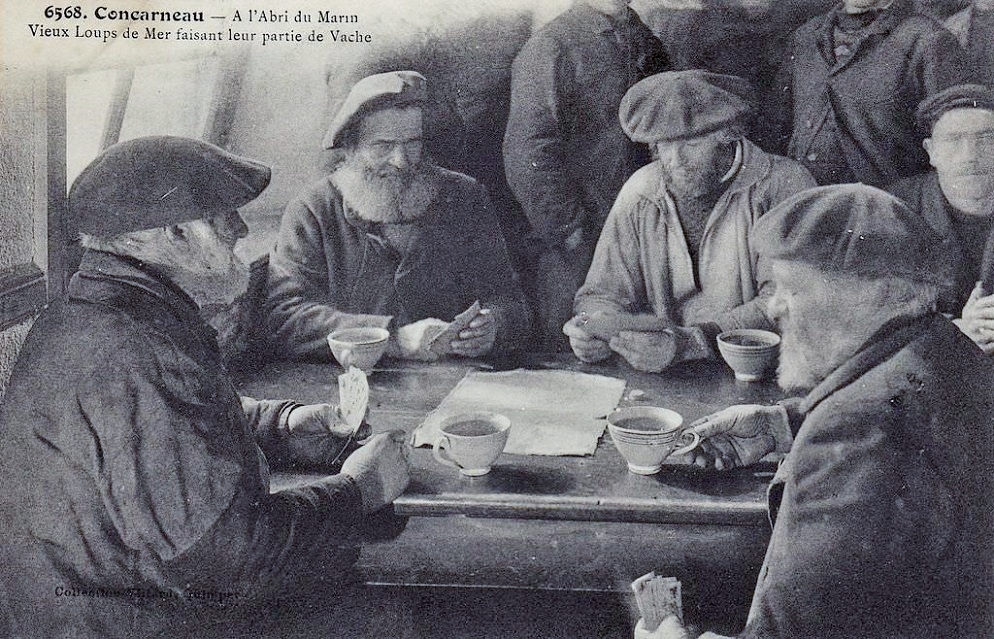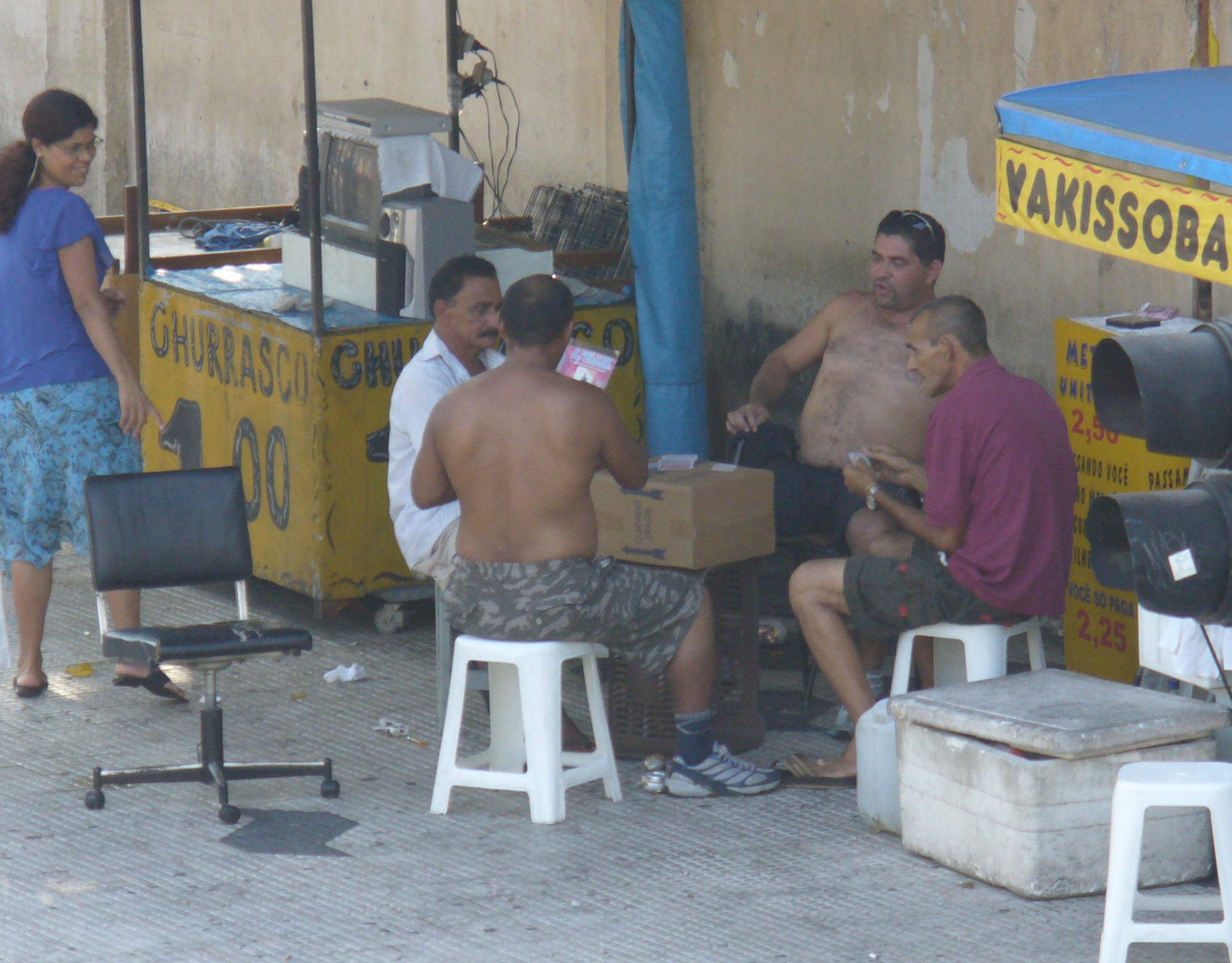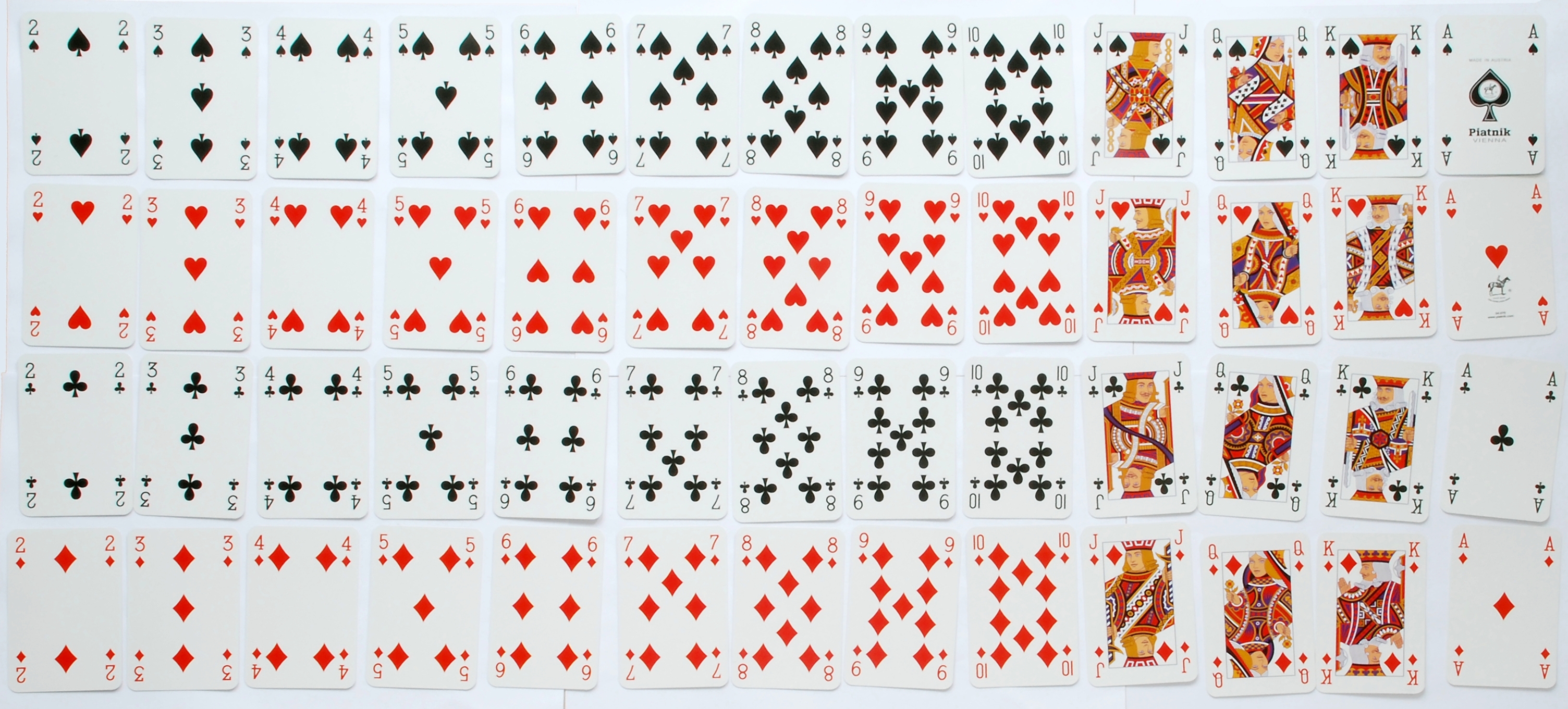|
Aluette
Aluette or Vache ("Cow") is an old, plain trick-taking card game that is played on the west coast of France. It is played by two teams, usually of four people, but sometimes also of six. It is unusual in using a unique pack of 48 Spanish playing cards and a system of signalling between playing partners. The French colloquial names for the game, ''jeu de la Vache'' or ''Vache'', refer to the cow depicted on one of the cards. History The game is very old, with references to the game of "luettes" by François Rabelais in the early 16th century. As the cards use Spanish playing cards, Spanish suits, Aluette may even predate the invention of French playing cards around 1480. "''La luette''" means uvula in French and may refer to the fact that it is played with codified signs that allow team members to provide information on their cards during the game. The game is also called "''la vache''" (the cow) because of the illustration on the 2 of cups card. Due to similarities it has with th ... [...More Info...] [...Related Items...] OR: [Wikipedia] [Google] [Baidu] |
Spanish Playing Cards
Spanish-suited playing cards or Spanish-suited cards have four suits, and a deck is usually made up of 40 or 48 cards (or even 50 by including two jokers). It is categorized as a Latin-suited deck and has strong similarities with the Portuguese-suited deck, Italian-suited deck and some to the French deck. Spanish-suited cards are used in Spain, Italy, parts of France, Hispanic America, North Africa, and the Philippines. Description Playing cards, originally of Chinese origin, were adopted in Mamluk Egypt by the 14th century if not earlier, and from there spread to the Iberian peninsula. The Spanish word (playing cards) is a loan word from ''nā'ib'', ranks of face cards found in the Mamluk deck. The earliest record of ''naip'' comes from a Valencian rhyming dictionary by Jaume March II in 1371, but without any context or definition. By 1380, ''naipero'' (card-maker) was a recognized profession. In December 1382, card games were banned from being played in Barcelona's ... [...More Info...] [...Related Items...] OR: [Wikipedia] [Google] [Baidu] |
Truco
Truco, a variant of Truc, is a trick-taking card game originally from Valencia and the Balearic Islands, popular in South America and Italy. It is usually played using a Spanish playing cards, Spanish deck. Two people may play, or two teams of two or three players each. Card ranking *Ace of Swords ("Espada" in Southeast of Brazil, "Espadão" in Southern Brazil, "Ancho de espada" in Argentina, "Macho" (male) in Paraguay, "Espadilla" in Uruguay) *Ace of Clubs ("Hembra" (female) in Paraguay, "Ancho de basto" in Argentina, "Bastillo" in Uruguay, "Bastião" in Southern Brazil) *7 of Swords ("Siete de espadas", "Siete bravo" in Uruguay, "Manilha de espada" in South of Brazil) *7 of Coins (''Siete de oros'' in Spanish or ''Sete ouro'', ''Sete belo'' or ''Maneca de ouro'' in Portuguese, "Siete bello" in Uruguay) *3s *2s (known as "Perruchos" in Paraguay) *Ace of cups and ace of coins (''Anchos falsos'' in Spanish, ''Ás falso'' in Southeast of Brazil, ''Gueime'' in South of Brazil, ... [...More Info...] [...Related Items...] OR: [Wikipedia] [Google] [Baidu] |
Truc
Truc, pronounced in France and in Spain, is a 15th-century bluff and counter-bluff trick-taking card game which has been likened to poker for two. It is played in Occitania, Sarthe (where it is known as ''trut''), Poitou (''tru'') and the Basque Country (greater region), Basque Country (''truka''), and is still very popular in the Valencia (province), Valencia region (''joc del truc''). More elaborate versions are widely played in Argentina, Uruguay, Venezuela, Paraguay and Brazil under such names as Truco, Truque and Truquiflor. The French version ''Le Truc'' has become more widely known in the English-speaking world and among hobbyist gamers after Sid Sackson included it in his popular book ''A Gamut of Games'' (1969),Sackson (1969), pp. 14–17. it being a translation of E. Lanes' 1912 book, ''Nouveau Manuel Complet des Jeux de Cartes''. History The game of Truc probably originates from the end of the Middle Ages in Spain, regarding the etymology of the word, which means "tr ... [...More Info...] [...Related Items...] OR: [Wikipedia] [Google] [Baidu] |
French Playing Cards
French-suited playing cards or French-suited cards are playing cards, cards that use the French Playing card suit, suits of (clovers or clubs ), (tiles or diamonds ), (hearts ), and (pikes or spades ). Each suit contains three or four face cards, face/court cards. In a standard 52-card deck these are the (jack (playing card), knave or jack), the (queen (playing card), lady or queen), and the (king (playing card), king). In addition, in Tarot packs, there is a (Knight (playing card), knight) ranking between the queen and the jack. Aside from these aspects, decks can include a wide variety of regional and national patterns, which often have stripped deck, different deck sizes. In comparison to Spanish playing cards, Spanish, Italian playing cards, Italian, German playing cards, German, and Swiss playing cards, French cards are the most widespread due to the geopolitical, commercial, and cultural influence of France, the United Kingdom, and the United States ... [...More Info...] [...Related Items...] OR: [Wikipedia] [Google] [Baidu] |
Truc
Truc, pronounced in France and in Spain, is a 15th-century bluff and counter-bluff trick-taking card game which has been likened to poker for two. It is played in Occitania, Sarthe (where it is known as ''trut''), Poitou (''tru'') and the Basque Country (greater region), Basque Country (''truka''), and is still very popular in the Valencia (province), Valencia region (''joc del truc''). More elaborate versions are widely played in Argentina, Uruguay, Venezuela, Paraguay and Brazil under such names as Truco, Truque and Truquiflor. The French version ''Le Truc'' has become more widely known in the English-speaking world and among hobbyist gamers after Sid Sackson included it in his popular book ''A Gamut of Games'' (1969),Sackson (1969), pp. 14–17. it being a translation of E. Lanes' 1912 book, ''Nouveau Manuel Complet des Jeux de Cartes''. History The game of Truc probably originates from the end of the Middle Ages in Spain, regarding the etymology of the word, which means "tr ... [...More Info...] [...Related Items...] OR: [Wikipedia] [Google] [Baidu] |
Put (card Game)
Put, occasionally Putt, is an English tavern game first recorded in the 16th century and later castigated by 17th century moralists as one of ill repute.Parlett (1995), pp. 27–28. It belongs to a very ancient family of trick-taking card games and bears close similarities a group known as ''Truc, Trut,'' ''Truque'', also ''Tru'', and the South American game Truco. Its more elaborate cousin is the Catelan and Spanish game of Truc, which is still much played in many parts of Southern France and Spain. Etymology The name Put, pronounced "uh" like the "u" in the English village of Putney, derives from "putting up your cards in case", if you do not like them, or from "putting each other to the shift". Cotton spells it Putt. History Put is mentioned as early as 1662 where the opening line of a poem, ''The Riddle'', says "S-hall's have a Game at Put, to pass away the time..." It appears in a compendium of poems and songs from the period 1639–1661. The rules of Put are recorded a ... [...More Info...] [...Related Items...] OR: [Wikipedia] [Google] [Baidu] |
Tours
Tours ( ; ) is the largest city in the region of Centre-Val de Loire, France. It is the Prefectures in France, prefecture of the Departments of France, department of Indre-et-Loire. The Communes of France, commune of Tours had 136,463 inhabitants as of 2018 while the population of the whole functional area (France), metropolitan area was 516,973. Tours sits on the lower reaches of the Loire, between Orléans and the Atlantic Ocean, Atlantic coast. Formerly named Caesarodunum by its founder, Roman Augustus, Emperor Augustus, it possesses one of the largest amphitheaters of the Roman Empire, the Tours Amphitheatre. Known for the Battle of Tours in 732 AD, it is a National Sanctuary with connections to the Merovingian dynasty, Merovingians and the Carolingian dynasty, Carolingians, with the Capetian dynasty, Capetians making the kingdom's currency the Livre tournois. Martin of Tours, Saint Martin and Gregory of Tours were from Tours. Tours was once part of Touraine, a former provi ... [...More Info...] [...Related Items...] OR: [Wikipedia] [Google] [Baidu] |
Angers
Angers (, , ;) is a city in western France, about southwest of Paris. It is the Prefectures of France, prefecture of the Maine-et-Loire department and was the capital of the province of Duchy of Anjou, Anjou until the French Revolution. The inhabitants of both the city and the province are called ''Angevins'' or, more rarely, ''Angeriens''. Angers proper covers and has a population of 154,508 inhabitants, while around 432,900 live in its metropolitan area (''aire d'attraction''). The Communauté urbaine Angers Loire Métropole, Angers Loire Métropole is made up of 29 communes covering with 299,500 inhabitants (2018).Comparateur de territoire INSEE Not including the broader metropolitan area, Angers is the third most populous Communes of France, commune in northwes ... [...More Info...] [...Related Items...] OR: [Wikipedia] [Google] [Baidu] |
Saint Pierre And Miquelon
Saint Pierre and Miquelon ( ), officially the Territorial Collectivity of Saint Pierre and Miquelon (), is a self-governing territorial overseas collectivity of France in the northwestern Atlantic Ocean, located near the Canada, Canadian province of Newfoundland and Labrador. An archipelago of eight islands, Saint Pierre Island, St. Pierre and Miquelon Island, Miquelon is a vestige of the once-vast territory of New France. Its residents are French citizens. The collectivity elects its own deputy to the National Assembly (France), National Assembly and participates in senatorial and presidential elections. It covers of land and had a population of 5,819 . Saint Pierre and Miquelon is an Overseas Countries and Territories, Overseas Country and Territory (OCT) of the European Union, although not an integral part of it. It is neither part of the Schengen Area, Schengen area, nor of the European customs territory. On the other hand, Saint Pierre and Miquelon is part of the Eurozone ... [...More Info...] [...Related Items...] OR: [Wikipedia] [Google] [Baidu] |
La Rochelle
La Rochelle (, , ; Poitevin-Saintongeais: ''La Rochéle'') is a city on the west coast of France and a seaport on the Bay of Biscay, a part of the Atlantic Ocean. It is the capital of the Charente-Maritime Departments of France, department. With 78,535 inhabitants in 2021, La Rochelle is the most populated commune in the department and ranks fourth in the Nouvelle-Aquitaine region after Bordeaux, the regional capital, Limoges and Poitiers. Situated on the edge of the Atlantic Ocean the city is connected to the Île de Ré by a bridge completed on 19 May 1988. Since the Middle Ages the harbour has opened onto a protected strait, the Pertuis d'Antioche and is regarded as a "Door océane" or gateway to the ocean because of the presence of its three ports (fishing, trade and yachting). The city has a strong commercial tradition, having an active port from very early on in its history. The city traces its origins to the Gallo-Roman culture, Gallo-Roman period, attested by the rema ... [...More Info...] [...Related Items...] OR: [Wikipedia] [Google] [Baidu] |
Cherbourg
Cherbourg is a former Communes of France, commune and Subprefectures in France, subprefecture located at the northern end of the Cotentin peninsula in the northwestern French departments of France, department of Manche. It was merged into the commune of Cherbourg-Octeville on 28 February 2000,Décret 23 February 2000 which was merged into the new commune of Cherbourg-en-Cotentin on 1 January 2016. Cherbourg is protected by Cherbourg Harbour, between La Hague and Val de Saire, and the city has been a strategic position over the centuries, disputed between the English and French. Cited as one of the "keys to the kingdom" by Sébastien Le Prestre de Vauban, Vauban, it became, by colossal maritime development work, a first-rate military port under the ... [...More Info...] [...Related Items...] OR: [Wikipedia] [Google] [Baidu] |







